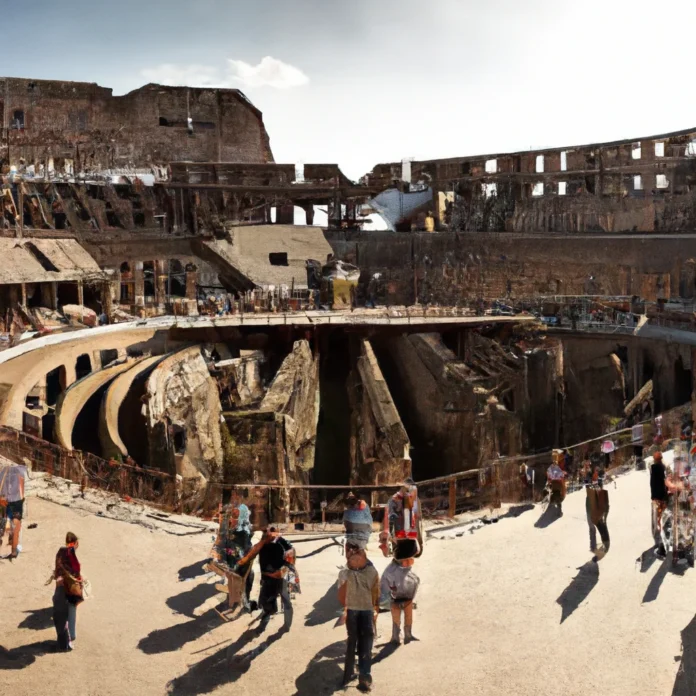Expert Guided Tour of Colosseum Arena OR Underground, and Forum
The Colosseum, a monumental symbol of ancient Rome, stands as a testament to the ingenuity and architectural prowess of the Roman Empire. This iconic structure has captivated millions of visitors each year, offering an unparalleled glimpse into the historical significance of gladiatorial games and public spectacles. In this comprehensive guide, we will provide an expert-led tour of the Colosseum Arena, the Underground, and the Roman Forum, ensuring an enriching experience for all who seek to understand this remarkable landmark.
Understanding the Colosseum: A Historical Overview
The Colosseum, also known as the Flavian Amphitheatre, was commissioned by Emperor Vespasian in 70 AD and completed in 80 AD under his successor, Titus. This colossal structure was primarily used for gladiatorial contests and public spectacles such as animal hunts, mock sea battles, and executions. With a seating capacity of approximately 50,000 spectators, the Colosseum was the epicenter of entertainment in ancient Rome.
The Structural Marvel of the Colosseum
Constructed using travertine limestone, tuff, and brick-faced concrete, the Colosseum’s architecture is an extraordinary feat. Its elliptical shape, measuring about 189 meters long and 156 meters wide, is a prime example of Roman engineering. The arena itself spans 83 meters in length and 48 meters in width, providing ample space for various events. The Colosseum features a complex system of vaults and arches, which not only support the weight of the structure but also enhance its aesthetic appeal.
The Colosseum Arena: A Closer Look
Visiting the arena floor offers a unique perspective on this ancient venue. The arena is where gladiators fought, and it serves as a poignant reminder of the valor and brutality of these contests. Guided tours often include access to the arena floor, allowing visitors to stand where countless battles were fought. The view from the arena offers insights into the seating arrangements, which were stratified according to social class, highlighting the societal structure of ancient Rome.
Exploring the Underground Chambers
The underground area, known as the hypogeum, is a fascinating aspect of the Colosseum that many visitors overlook. This subterranean network consists of a series of tunnels and chambers where gladiators and animals were kept before their performances. The hypogeum was a hive of activity, with slave labor ensuring the smooth operation of events. Access to this area is typically included in guided tours, providing insight into the logistical aspects of managing the spectacles.
The Roman Forum: The Heart of Ancient Rome
Adjacent to the Colosseum lies the Roman Forum, the political, social, and economic center of ancient Rome. This expansive site includes the ruins of several important structures, such as the Senate House, the Temple of Saturn, and the Rostra, where orators addressed the public. A guided tour of the Forum enriches understanding of Roman life, governance, and architecture.
Importance of Guided Tours
Engaging with a knowledgeable guide enhances the experience of visiting the Colosseum and the Roman Forum. Guides provide context, historical anecdotes, and insights that are often missed by self-guided explorers. Moreover, a guided tour typically includes priority access, allowing visitors to bypass long queues and maximize their time.
How to Book on Viator
Booking your guided tour of the Colosseum and Roman Forum is simple through Viator. By visiting the following link, you can choose from various tour options that fit your schedule and preferences: Book your tour on Viator. The site offers comprehensive details on different packages, ensuring you find an option that meets your needs.
Visiting Tips and Recommendations
When planning your visit to the Colosseum and the Roman Forum, consider the following tips:
- Advance Booking: Due to the popularity of these sites, it is advisable to book your tickets in advance to secure your spot.
- Dress Appropriately: Comfortable footwear is essential, as visitors will be walking on uneven surfaces.
- Timing: Early morning or late afternoon visits can help you avoid the peak crowds and enjoy a more serene experience.
- Stay Hydrated: Bring water, especially during the warmer months, as you will be walking extensively.
Conclusion
The Colosseum and Roman Forum are not merely ruins; they are storied landmarks that narrate the grandeur of ancient Rome. Engaging in an expert-guided tour will significantly enrich your understanding of these historical sites. We encourage you to consider booking a tour through Viator for a seamless experience. For further travel insights and lifestyle content, visit Izase, where we bring you the best recommendations for your next adventure.
Disclaimer: This information is accurate to the best of our knowledge; however, there may be changes or mistakes. Please verify exact details on the Viator booking page.


